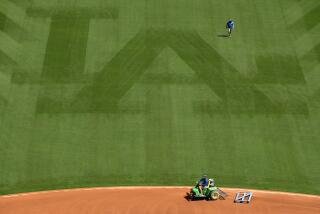In a Grand Old Game, What Goes Around Comes Around
The Baltimore Orioles’ beautiful new ballpark is a beautiful old ballpark. It has an orange brick exterior, black wrought-iron gates, aisle seats stamped with the club’s 1890s logo, steel scaffolding above the center-field bleachers, a Gothic-styled clock atop the scaffolding and ads for Esskay Franks on the outfield fences.
The Philadelphia Phillies’ brand new uniforms are their old brand of uniforms. The watermelon-red pinstripes, the cursive-scripted “Phillies” across the chest, the blue star that dots the ‘i’--they’ve stolen the shirts off the backs of the 1950 Whiz Kids.
And they are not alone.
In Chicago, the recently retro-fied look of the White Sox has become the rage of the sports wear shops of America.
In Atlanta, the Braves didn’t start winning until they turned back their sartorial clock to 1957.
In St. Louis, the navy Cardinal hats of the Stan Musial Era have been sighted on the heads of Andres Galarraga and Felix Jose.
In Denver and Arlington, Tex., new stadiums are being designed with the same aesthetically correctness as Oriole Park at Camden Yards--a spectacle so immense they had to name it twice.
In a major league catch phrase, older has become better.
And on the surface, you have to ask: Why not? Like Rip Van Winkle, baseball is just awakening from a 20-year slumber--roughly, 1965 to 1985--where taste was something you did to a hot dog and style was dictated by carnival barkers named Charlie Finley and Bill Veeck.
UFOs with fiberglass shells and plastic carpets landed in Houston, Seattle and Minneapolis and they called them baseball stadiums. Doughnut-shaped assembly-line clones popped up in Pittsburgh, Philadelphia, Cincinnati and St. Louis. In 1966, a safe and sterile annex to Disneyland--”Never Never Land”?--was built a couple of miles east on Katella and they moved the Angels there.
And if clothes make the man, baseball fashion during those years made the players look like idiots. The Houston Astros’ Rainbow Coalition. The “We Are Bumblebee” Pittsburgh Pirates. The Taco Bell Padres. The Mustard Spill Athletics. The Chicago Black Shorts Scandal of 1976.
Experiments in contemporary design, they were called at the time.
Evidence of temporary insanity, that is the present-day consensus.
Two seminal events in the 1980s shoved baseball’s nose into the smelling salts.
1984: A team wearing brown-and-orange shirts plays in the World Series.
1987: A team playing inside a mutant Kaiser roll wins the World Series.
Clearly, something needed to be done.
The veer toward yesteryear has made baseball easier on the eye--although turning the ’92 Expos into the ’83 Brewers is a change that still must be explained--and that’s nothing compared to what it has done for the psyche. Baseball was better then. We have been told that. Even if we weren’t there then, we assume it.
Baseball then: Joe DiMaggio.
Baseball today: Rob Dibble.
Baseball then: “The batteries for today’s game . . . “
Baseball today: “The battery charges have been dropped . . . “
Baseball then: Ten cards and a stick of pink bubble gum for a nickel.
Baseball today: One Frank Thomas card for $85.
No other sport yearns for the golden years and basks in the past the way baseball does. How else can one explain the popularity of “Field of Dreams”? (A: There is no other rationale response known to man.) How else can one explain the popularity of the Chicago Cubs? The Cubs’ failure to win even one pennant since 1945 is not viewed as a disgrace; it is considered part of their “charm.”
Pro football peaked in the 1960s, but you see no Tom Matte mania, no Kezar Stadium nostalgia, no odes to Fuzzy Thurston. The Packers, no doubt, would like to quantum-leap back 25 years--and once they thought hiring Bart Starr to coach them would do the trick. Punt blocked. Now, the Packers hire the state of the art and bring in Mike Holmgren, guru to the up-to-the-minute Joe Montana passing scheme.
Pro basketball has a quaint past and those old grainy films of Bob Cousy on the fast break are as close to sheer Saturday-morning cartoon fun as Babe Ruth swinging and waddling. But suppose the NBA adopted major league baseball’s approach. Michael Jordan would be wearing Chuck Taylors tomorrow and the Washington Bullets would be moving into a barn just outside Alexandria, with peach baskets nailed to plywood backboards and a pot-bellied furnace leaning over the baseline.
“Don’t look back, something might be gaining on you,” was advice offered by the old pitcher, Satchel Paige. Baseball smiles when it hears those words, but it hasn’t taken them seriously, not lately anyway.
Look back, you might be able to gain something--that is baseball’s current take on the idea. Maybe the past was better. If it was, and if you can at least look the part, maybe the rest will follow.
It makes sense when you read the rule book.
Baseball is the one sport where you can go home again.
More to Read
Go beyond the scoreboard
Get the latest on L.A.'s teams in the daily Sports Report newsletter.
You may occasionally receive promotional content from the Los Angeles Times.










